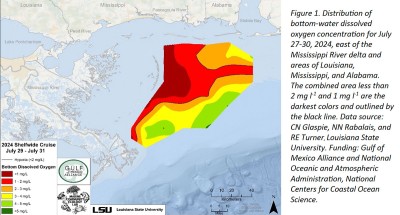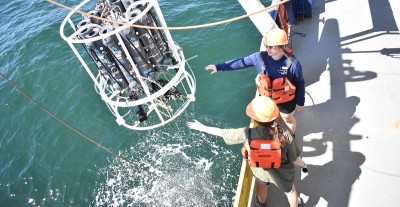LSU Professor Releases Annual Study of Gulf Dead Zone Caused by Polluted Mississippi River Water
A NOAA-supported scientific team led by LSU Scientist, Nancy Rabalais, PhD, announced in a press release this week that the Gulf of America hypoxic ‘dead zone’ — an area of low to no oxygen that can kill fish and marine life — is approximately 4,772 square miles (12,360 square kilometers), about the size of Connecticut, or seven times larger than Lake Pontchartrain.
Upon further research, the Mississippi Sound Coalition has learned that Dr. Rabalais’ study covers only areas to the west of the Mississippi and that another team will be releasing results from a study of the area east of the Mississippi (closer to the Mississippi Sound.)

To read our 2024 blog about the dead zone, click here: https://saveoursoundms.org/dead-zone-found-near-mississippi-sound/
Media Release
(Media Release July 31, 2025) NOAA-supported scientists determined that this year’s Gulf of America ‘dead zone’ — an area of low to no oxygen that can kill fish and marine life — is approximately 4,772 square miles (12,360 square kilometers), about the size of Connecticut or seven times larger than Lake Pontchartrain. The area represents potentially unavailable habitat for fish and bottom organisms.
scientists determined that this year’s Gulf of America ‘dead zone’ — an area of low to no oxygen that can kill fish and marine life — is approximately 4,772 square miles (12,360 square kilometers), about the size of Connecticut or seven times larger than Lake Pontchartrain. The area represents potentially unavailable habitat for fish and bottom organisms.
Scientists at Louisiana State University and the Louisiana Universities Marine Consortium conducted the annual dead zone survey on July 20–25 aboard LUMCON’s research vessel Pelican. This annual measurement is a key metric that informs the collective efforts of the Mississippi River/Gulf of America Hypoxia Task Force, a state/federal partnership which has set a long-term goal of reducing the five-year average extent of the dead zone to fewer than 1,900 square miles by 2035.
While the NOAA-supported research surveys provide a one-time snapshot of the dead zone, the five-year average captures the dynamic and changing nature of the zone over time. The five-year average size of the dead zone is now 4,440 square miles, more than two times larger than the 2035 target.
The measured size, although lower than estimated by the ensemble model forecast, fell within the uncertainty range, demonstrating the overall accuracy of the underlying models and their ability to be applied as tools for nutrient reduction strategies.
Further information: cassandra.glaspie@gmail.com, nrabal@lsu.edu, euturne@lsu.edu